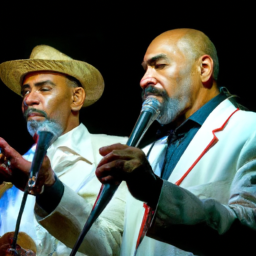Exploring the Roots of Cuban Music: A Look at the Genres and Influences That Have Shaped Cuban Music
Cuban music is a vibrant and diverse genre that has been shaped by a variety of influences over the centuries. From its African roots to its Spanish and Caribbean influences, Cuban music has evolved into a unique and captivating sound. This article will explore the various genres and influences that have shaped Cuban music, providing an overview of its history and development.
The African influence on Cuban music is perhaps the most significant. African slaves brought their own musical traditions to the island, which blended with the Spanish and Caribbean influences to create a unique sound. African rhythms and instruments, such as the conga drum, are still prominent in Cuban music today. The African influence is also evident in the use of call-and-response vocals, which are a common feature of Cuban music.
The Spanish influence on Cuban music is also significant. Spanish settlers brought their own musical traditions to the island, which blended with the African and Caribbean influences to create a unique sound. Spanish instruments, such as the guitar and tres, are still prominent in Cuban music today. The Spanish influence is also evident in the use of flamenco-style rhythms and melodies, which are a common feature of Cuban music.
The Caribbean influence on Cuban music is also significant. Caribbean music, such as reggae and calypso, has had a major impact on Cuban music. Caribbean rhythms and instruments, such as the steel drum, are still prominent in Cuban music today. The Caribbean influence is also evident in the use of syncopated rhythms and melodies, which are a common feature of Cuban music.
Finally, the American influence on Cuban music is also significant. American jazz and blues have had a major impact on Cuban music, particularly in the development of the popular Cuban music genre known as salsa. American instruments, such as the trumpet and saxophone, are still prominent in Cuban music today. The American influence is also evident in the use of improvisation and syncopation, which are a common feature of Cuban music.
In conclusion, Cuban music has been shaped by a variety of influences over the centuries. African, Spanish, Caribbean, and American influences have all contributed to the development of this unique and captivating genre. By exploring the various genres and influences that have shaped Cuban music, we can gain a better understanding of its history and development.
The Evolution of Cuban Music: How Cuban Music Has Changed Over Time

Cuban music has been a major influence on the music of the world for centuries. It has evolved over time, incorporating elements from other cultures and adapting to the changing times. From its roots in African rhythms to its modern-day fusion of Latin and Caribbean styles, Cuban music has been a major force in the development of popular music.
The earliest Cuban music was heavily influenced by African rhythms and instruments. African slaves brought to the island by the Spanish in the 16th century brought with them their own musical traditions, which blended with the Spanish and indigenous music of the island. This early Cuban music was known as “son” and was characterized by its use of percussion instruments such as the claves, maracas, and bongos.
In the 19th century, Cuban music began to incorporate elements of European classical music, particularly from Spain and France. This new style of music was known as “danzón” and was characterized by its use of string instruments such as the violin and guitar. Danzón was popular among the upper classes of Cuban society and was often performed in the salons of wealthy families.
In the early 20th century, Cuban music began to incorporate elements of jazz and blues from the United States. This new style of music was known as “mambo” and was characterized by its use of horns and improvisation. Mambo was popularized by the Cuban bandleader and composer, Desi Arnaz, and was a major influence on the development of salsa music.
In the late 20th century, Cuban music began to incorporate elements of rock and pop from the United States and Europe. This new style of music was known as “timba” and was characterized by its use of electric instruments and synthesizers. Timba was popularized by the Cuban bandleader and composer, Juan Formell, and was a major influence on the development of Latin pop music.
Today, Cuban music continues to evolve, incorporating elements from other cultures and adapting to the changing times. It is a vibrant and diverse musical tradition that has had a major influence on the music of the world.
The Impact of Cuban Music on the World: How Cuban Music Has Influenced Other Genres and Cultures
Cuban music has had a profound impact on the world, influencing a variety of genres and cultures. From the traditional Cuban son to the modern salsa, Cuban music has been embraced by many countries and cultures, and has been adapted to fit their own unique styles.
The traditional Cuban son is a style of music that originated in the 19th century and is still popular today. It is a combination of Spanish and African influences, and is characterized by its syncopated rhythms and call-and-response vocals. This style of music has been embraced by many countries, including Mexico, Puerto Rico, and the Dominican Republic. In Mexico, the son has been adapted to create the popular genre of music known as mariachi. In Puerto Rico, the son has been adapted to create the popular genre of music known as plena. In the Dominican Republic, the son has been adapted to create the popular genre of music known as merengue.
The modern salsa is a style of music that originated in the 1960s and is still popular today. It is a combination of Cuban, Puerto Rican, and other Latin American influences, and is characterized by its fast-paced rhythms and improvisational vocals. This style of music has been embraced by many countries, including the United States, Colombia, and Venezuela. In the United States, salsa has been adapted to create the popular genre of music known as Latin jazz. In Colombia, salsa has been adapted to create the popular genre of music known as cumbia. In Venezuela, salsa has been adapted to create the popular genre of music known as vallenato.
Cuban music has also had a profound impact on other genres and cultures. For example, the traditional Cuban son has been embraced by jazz musicians, and has been adapted to create the popular genre of music known as Afro-Cuban jazz. This style of music combines traditional Cuban son with jazz improvisation, and has been embraced by many countries, including the United States, Canada, and Europe.
In conclusion, Cuban music has had a profound impact on the world, influencing a variety of genres and cultures. From the traditional Cuban son to the modern salsa, Cuban music has been embraced by many countries and cultures, and has been adapted to fit their own unique styles. As a result, Cuban music has had a lasting impact on the world, and will continue to influence other genres and cultures for years to come.

